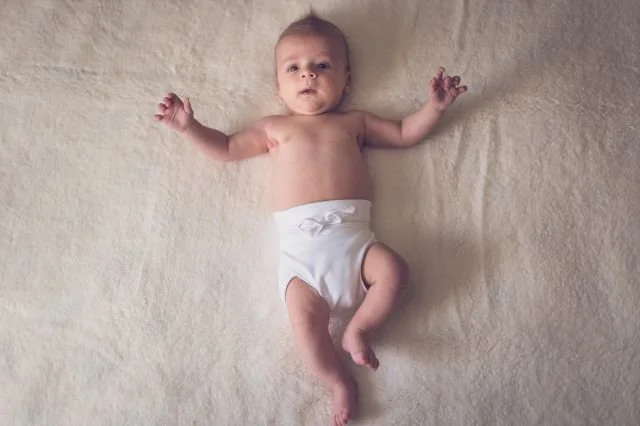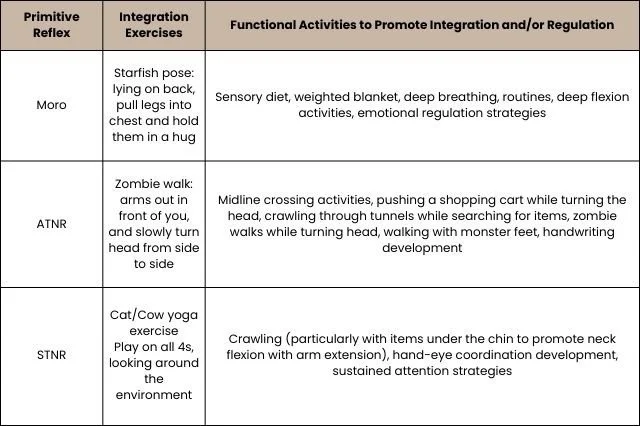What is retaining a newborn reflex?
Ben Robison, OTR/L
By Kaitlyn Watts, OT graduate student clinician
Was your child slow to crawl? Or do they startle any time a balloon pops or fireworks explode? Do they bump into items frequently or seem unaware of their body position? Maybe they are hypersensitive to the waistband on their pants or lay on their arm when writing long sentences. Although any of these things could be due to a variety of causes, one contributor might be a retained newborn reflex, also known as a primitive reflex.
What is a primitive reflex?
They are normal, involuntary patterns of movement that are present in all of us at birth and become dormant (or integrated) before the child reaches 12 months of age. These natural reflexes promote motor learning and sensory integration in order to evolve into more complex movement patterns.
Retained primitive reflexes and why it matters
If primitive reflexes are still present after 12 months of age, they are considered to be a retained primitive reflex. They can interfere with a child’s typical development and can lead to faulty and maladaptive movement patterns. They might also interfere with your child’s ability to play, focus on school tasks, complete activities like dressing or toileting, and engage in family activities. Some general symptoms of retained reflexes include decreased coordination, gross motor challenges, poor handwriting at age level, poor hand-eye coordination, clumsiness, hypersensitivity to sound/touch/movement, poor ability to sit still, picky eating, developmental delays, and poor visual skills. There are 6 primitive reflexes, and we will look at 3: the Moro reflex, the ATNR reflex, and the STNR reflex.
The Moro Reflex causes babies to reach and spread their arms in response to stimuli like loud noises.
Moro Reflex:
Also known as the startle reflex, this is an involuntary reaction to what is perceived as an outside threat, or sudden stimuli. Things like loud noises, a sudden change in the visual field, or the feeling of being dropped elicits this reflex. The flight-or-fight response is triggered very quickly, resulting in increased production of stress hormones. This reflex should be integrated by 4 months of age. Potential symptoms that it hasn’t been integrated include:
Easily startled and fearful in new situations; anxiety
Hypersensitivity to sound, light, touch
Poor coordination
Limited attention span and easy distractibility
Poor balance; gravitational insecurities
Motion sickness
Decreased hand-eye coordination
Exhibits difficulty making decisions
Has troubles with social skills
Exhibits poor emotional regulation
Low immune system, allergies
ATNR:
The asymmetrical tonic neck reflex is an involuntary motor reaction in response to the head turning to the right or left. The arm and leg will straighten on the side in which the head turned and the opposite arm and leg will bend. It helps build muscle tone, reaching and exploratory skills on both sides of the body, and hand-eye coordination. It should be integrated by FOUR MONTHS OF AGE. Signs that it has not integrated include:
Difficulty rolling/crawling
Poor balance and stability; clumsy
Lack of coordination
Challenges crossing midline (reaching across body during tasks like brushing teeth or getting dressed)
Poor hand-eye coordination
Handwriting difficulties (presses too hard on the paper, loses place on the page, hand becomes easily fatigued)
Poor visual skills (difficulty copying from the board, unable to visually track, dyslexic tendencies)
The STNR is sometimes called the crawling reflex.
STNR:
The Symmetrical Tonic Neck Reflex, sometimes known as the crawling reflex, assists the infant with moving from laying on their belly onto their hands and knees (quad). The STNR links your baby's head movements to their arm and leg movements. The reflex does not develop until about 4 months of age and should be integrated by TEN MONTHS OF AGE.
Some potential symptoms of a retained STNR in toddlers and children are:
Challenges with crawling
Poor posture, low muscle tone
W-sitting
Clumsiness
Poor sustained attention
Challenges with reading and writing
How can occupational therapy address retained reflexes?
If you feel like your child is experiencing functional challenges that might be due to a retained reflex, we can help. Our team will observe your child play, interview you as a caregiver, and perform specific tests to determine if your child has a retained reflex. We will then include exercises to integrate the retained reflex into their play routine. Goals of these exercises include increasing body awareness, bilateral coordination, controlled movements, crossing midline, and sensory processing.
Children learn through play and repetition; especially at home in their natural environment. As a caregiver, you can incorporate reflex exercises into your family’s daily routine! Specific integration exercises can be seen in the chart below:
Chart adapted from: https://pktherapyot.com/2020/05/09/primitive-reflexes-and-daily-activities/




